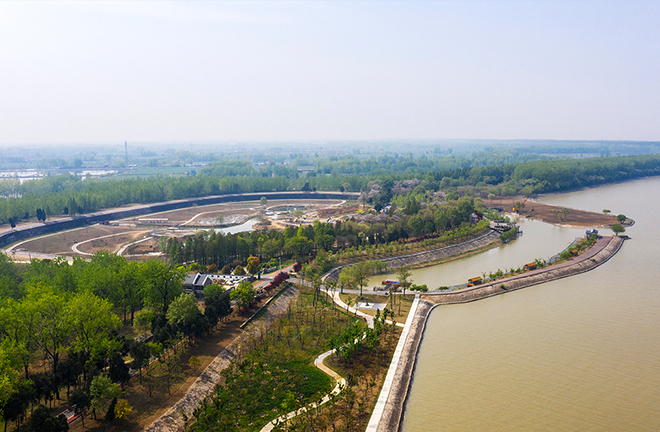National Park displays Grand Canal culture

An aerial view of the Grand Canal National Cultural Park Photo: CFP
The Grand Canal, the world’s earliest and longest artificial river, has played a role in the development of Chinese society and history. At the end of April, after 14 days’ water replenishment, the Beijing-Hangzhou section of the Grand Canal has flowed with water along the whole line for the first time over the past century, which marks that the section, with more than 2,500 years of history and nearly 1,800 km in length, ushers in a centennial recovery.
Cultural heritage
The digging of canals in China can be traced back to the 5th century BCE during the Spring and Autumn Period (770–476 BCE). It then underwent more than 2,000 years of development and evolution. Connecting the Yellow River, Huai River, Yangtze River, and other important water systems, the Grand Canal has historically performed an instrumental role in the flow of people as well as the trade and circulation of goods between the north and the south.
The country attaches great importance to the Grand Canal’s cultural protection. In August 2021, the construction and protection plan for the Grand Canal National Cultural Park was issued, which proposed further interpreting the canal’s cultural value, vigorously carrying forward its zeitgeist, intensifying regulation and protection, and striving to build the Grand Canal National Cultural Park into an intriguing brand that publicizes Chinese image, showcases Chinese civilization, and demonstrates cultural confidence.
The park consists of three parts: the Beijing-Hangzhou Grand Canal, the Grand Canal of the Sui (581–618) and Tang (618–907) dynasties, and the Zhedong Canal. Since the 1970s, due to insufficient water supply, the Grand Canal in the north of the Yellow River has been in decline. The river way has gradually shrunk, and the river bank has been constantly degraded, cutting off water and navigation. With economic development and social progress, new requirements have been put forward on waterway construction. The whole-line flow of the Beijing-Hangzhou Grand Canal, a world-class canal, has become a common wish of the Chinese people. Its connection heralds that the canal, after governance, will continue to take on the role of water supply, transport, and shipping, becoming a veritable “gold waterway.”
According to He Yun’ao, director of the Institute of Cultural and Natural Heritage at Nanjing University, the whole-line flow of the Beijing-Hangzhou Grand Canal is an important achievement made in building the Grand Canal cultural belt and the Grand Canal National Cultural Park. It is a typical sign representing the cultural revitalization of the Beijing-Hangzhou Grand Canal, a move toward integrating the Grand Canal culture and tourism, and a vivid case of building the Grand Canal National Cultural Park and promoting ecological civilization construction.
The Beijing-Hangzhou Grand Canal, as an artificial water system that communicates between northern and southern China, has promoted cultural exchange among different regions, especially between the north and the south, said Lyu Zhou, director of the National Heritage Center at Tsinghua University. It has left considerable cultural relics that reflect the level of Chinese water conservancy and transportation technology and contain historical and scientific value. It has also preserved historical cultural remains and intangible cultural heritage that mirror cultural fusion and the development features of cultural regions. However, the protection of China’s canal heritage is still fragmented, and has not seen a unified system, while the construction of the Grand Canal National Cultural Park is an opportunity to reverse this situation.
Cultural industry
The digital development, utilization, and dissemination of traditional cultural resources cannot be separated from the continuous stimulation of digital production capacity. Bao Guoqiang, a professor from the School of Journalism and Communication at Shanghai University, suggested innovating the digital mode of protecting, activating, and utilizing Grand Canal intangible cultural heritage in a live state, enhancing the international transmission capacity of Grand Canal culture. It is necessary to rely on digital technology to deepen the integration of Grand Canal culture and cultural tourism, stimulating the digital production capacity of Grand Canal cultural development and utilization.
According to the recently issued plan for the Hangzhou Grand Canal National Cultural Park, Hangzhou will strive to create a classic Grand Canal National Cultural Park based on the Hangzhou section, serving as a cultural ecological practice model of Zhejiang Province’s high-quality development and construction of common prosperity demonstration areas.
Liu Jiaming, a research fellow from the Institute of Geographic Sciences and Natural Resources Research at the Chinese Academy of Sciences, believes that the Grand Canal National Cultural Park should be forged with key points, selecting representative and advantageous regions as key development areas to form a demonstration effect. At the same time, it is advisable to avoid homogenous imitation and mechanized copying of other regions’ construction experience, integrate the local culture of each region into the Grand Canal National Cultural Park to form differentiated marks, and build the park into a trinity of sightseeing, leisure, and vacation.
At present, the construction of the park is still in the initial stage. Its theoretical research lags behind practice. Unbalanced regional development is prominent, and local practice is in urgent need of professional guidance. Its social popularity is still low, a cultural governance model has yet to be established, and public management levels need to be improved.
The construction of the park helps protect key national heritage, develops cultural tourism and the leisure industry, fosters national consciousness, ensures public cultural services and citizens’ rights to cultural leisure, and advances the cultural industry. Wu Chengzhong, a professor from the School of Government at the University of International Business and Economics, called for the scientific development path of the park as well as the national standard and scientific evaluation system of national-level cultural parks.
Edited by YANG LANLAN

 PRINT
PRINT CLOSE
CLOSE